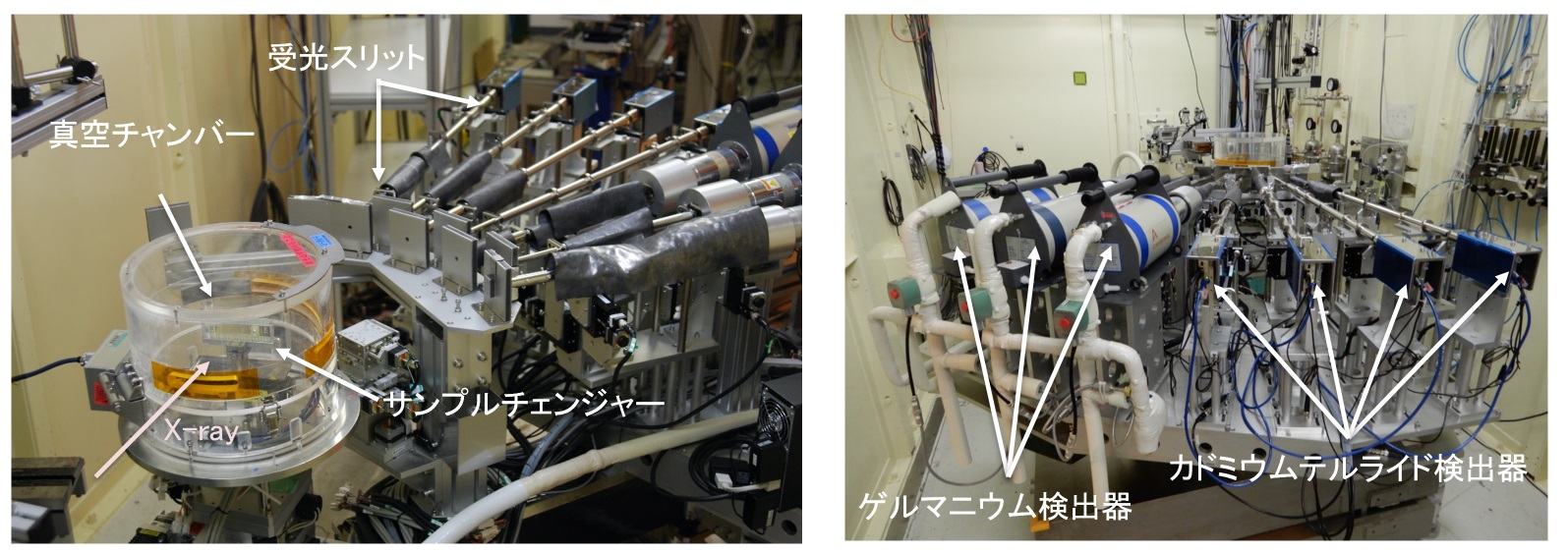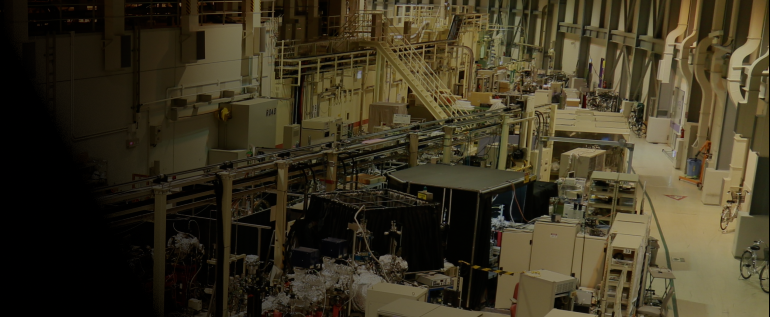検出器7連装PDF解析装置
◆装置概要
液体や非晶質物質の精密なPDF構造解析を行うことができます。CO2レーザーとガス浮遊を組み合わせた超高温計測や、高エネルギーX線を利用した非破壊内部分析にも対応しています。

◆装置の特徴
水平二軸回折計θ、2θの水平振り2軸回折計であり、バックグラウンドを低減させるためにポイント型検出器の前に受光ダブルスリットを搭載しています。広いQ範囲のデータから高い実空間分解能のPDF解析データを取得することが可能です。(Qmax<30Å-1)
検出器
高エネルギー対応のCdTe半導体検出器4台とGe半導体検出器3台を採用しています。8度間隔で配置し、短時間で広いQ空間のデータを収集することが可能です。
CdTe半導体検出器(搭載モデル:X-123CdTe)の詳しい仕様はこちらから。(https://www.amptek.com/products/sdd-x-ray-detectors-for-xrf-eds/x-123sdd-complete-x-ray-spectrometer-with-silicon-drift-detector-sdd)
Ge半導体検出器(搭載モデル:GL0515)の詳しい仕様はこちらから。(http://www.gammadata.se/assets/Uploads/LEGe-SS-C49322.pdf)
制御ソフトウェア
JASRIにて製作したGUI中心の制御となっています。詳しい仕様はこちらから。(http://rud.spring8.or.jp/member/0020758/BL04B2_control_ver0.pdf)
◆装置アクセサリー
高温電気炉(リガク製、室温〜1,100℃)
ガス浮遊炉(800〜3,000℃)
窒素吹きかけ式低温装置(オックスフォード製:Cryojet5、-196℃〜室温)
クライオスタット(リガク製、-243℃〜室温)
◆実験・試料準備
試料容器としては、肉厚の薄いX線回折試料用キャピラリーがお勧めです(例えば、オーバーシーズ・エックスレイ・サービス製:http://www.oxs.co.jp)。内径2~3mm程度のサイズのものがよく使われます。
また、室温実験の場合、バックグラウンドを抑えたポリイミドチューブ(K-NEX製:http://www.kei-nex.com/process.html#pageLink01)も使われます。
試料をキャピラリーに充填し封止されて持ち込まれる場合、10-2Pa程度の真空度でリークチェックを事前にお願いします。
◆実験手順・注意事項
1.試料を二軸回折計のステージの上にマウントします。
2.実験ハッチから退出します。
3.ビームシャッターを制御ソフトウェアから開き、X線をサンプルへ照射します。そして、2θ軸を0.3°〜9°まで0.1°おきに200msecずつのクイック測定を行い、全散乱データを確認します。
4.散乱強度の一番強い2θの位置を探し、X方向(X線と直行する方向をXとしています)のスキャンを±2mmの範囲で行い、強度が最大となるXの値に調整します。
5.続いて、Z方向のスキャンを±1mmの範囲で行い、強度が最大となるZの値に調整します。
6.2θ軸を45°へ移動し、Y方向(X線の進行方向をYとしています)のスキャンを±3mmの範囲で行い、強度が最大となるYの値に調整します。
7.サンプルの位置出しが終了したら、本測定を開始します。測定は、2θが0.3°〜9°で、液体や非晶質物質は0.1°おきに1点あたり10sec程度、結晶物質は0.02°おきに1点あたり2sec程度の測定を行います。
8.7の測定を十分な統計精度が得られるまで繰り返します。
◆問い合わせ先
尾原 幸治(このメールアドレスはスパムボットから保護されています。閲覧するにはJavaScriptを有効にする必要があります。)
河口 沙織(このメールアドレスはスパムボットから保護されています。閲覧するにはJavaScriptを有効にする必要があります。)
山田 大貴(このメールアドレスはスパムボットから保護されています。閲覧するにはJavaScriptを有効にする必要があります。)
◆代表的な論文リスト
"Noncrystalline Nanocomposites as a Remedy for the Low Diffusivity of Multivalent Ions in Battery Cathodes"
Yuki Orikasa, Kazuaki Kisu, Etsuro Iwama, Wako Naoi, Yusuke Yamaguchi, Yoshitomo Yamaguchi, Naohisa Okita, Koji Ohara, Toshiyuki Munesada, Masashi Hattori, Kentaro Yamamoto, Patrick Rozier, Patrice Simon, and Katsuhiko Naoi
Chemistry of Materials, 32, (2020) 1011-1021
DOI : 10.1021/acs.chemmater.9b03665
"Lithium-ion Coordination-Induced Conformational Change of PEG Chains in Ionic-Liquid-Based Electrolytes"
Yuji Kamiyama, Masayuki Shibata, Ryo Kanzaki, and Kenta Fujii
Physical Chemistry Chemical Physics, 22, (2020) 5561-5567
DOI : 10.1039/c9cp06717e
"Structure and Negative Thermal Expansion in Zr0.3Sc1.7Mo2.7V0.3O12"
Huanli Yuan, Chunyan Wang, Qilong Gao, Xianghong Ge, Hao Sun, Saul H. Lapidus, Juan Guo, Mingju Chao, Yu Jia, and ErJun Liang
Inorganic Chemistry, 59, (2020) 4090-4095
DOI : 10.1021/acs.inorgchem.0c00126
"Very Sharp Diffraction Peak in Nonglass-Forming Liquid with the Formation of Distorted Tetraclusters"
Chihiro Koyama, Shuta Tahara, Shinji Kohara, Yohei Onodera, Didrik R. Småbråten, Sverre M. Selbach, Jaakko Akola, Takehiko Ishikawa, Atsunobu Masuno, Akitoshi Mizuno, Junpei T. Okada, Yuki Watanabe, Yui Nakata, Koji Ohara, Haruka Tamaru, Hirohisa Oda, Ippei Obayashi, Yasuyuki Hiraoka, and Osami Sakata
NPG Asia Materials, 12, (2020) 43
DOI : 10.1038/s41427-020-0220-0
"Synthesis, Electrochemical Properties, and Changes in Crystal and Electronic Structures during Charge/Discharge Process of Spinel-Type Cathod Materials Mg4V5-xNixO12 (x = 0, 0.3, 0.6, 1.0) for Magnesium Secondary Batteries"
Yasushi Idemoto, Natsumi Kawakami, Naoya Ishida, and Naoto Kitamura
Journal of Power Sources, 455, (2020) 227962
DOI : 10.1016/j.jpowsour.2020.227962
PDF Analysis Equipment with 7-Fold Multiple Detector
◆Equipment overview
Precise PDF structural analysis can be performed on liquid and amorphous substances. By combining a CO2 laser and floating gas, ultra-high temperature measurements can be taken, and by using high-energy X-rays, non-destructive internal analysis can be completed.

◆Features of the Equipment
Horizontal Biaxial DiffractometerA θ and 2θ axis horizontal swing diffractometer is equipped before the double-slit point-type detector, and exists to decrease the background. It is possible to obtain high real-space resolution PDF analysis data from a wide Q range of data.(Qmax<30A-1)
Detector
Four high-energy CdTe semiconductor detectors, and three Ge semiconductor detectors are used. By using intervals of 8 degrees, it is possible to collect wide Q space data in a very short time.
Click here for detailed specifications of the CdTe semiconductor detector (Equipped Model: X-123CdTe).
(https://www.amptek.com/products/sdd-x-ray-detectors-for-xrf-eds/x-123sdd-complete-x-ray-spectrometer-with-silicon-drift-detector-sdd)
Click here for detailed specifications of the Ge semiconductor detector (Equipped Model: GL0515).
(http://www.gammadata.se/assets/Uploads/LEGe-SS-C49322.pdf)
Control Software
This software is controlled by a GUI and was created by JASRI. Please click here for detailed specifications. (http://rud.spring8.or.jp/member/0020758/BL04B2_control_ver0.pdf)
◆Equipment accessories
High Temperature Electric Furnace (Manufactured by Rigaku: room temperature to 1,100℃)
Gas Suspension Furnace (800℃ to 3,000℃)
Low Temperature Nitrogen Spraying Device (Manufactured by Oxford: Cryojet 5, -196℃ to Room Temperature)
Cryostat (Manufactured by Rigaku: -243℃ to Room Temperature)
◆Experiment / sample preparation
It is recommended that a thin X-ray diffraction sample capillary is used for a sample container (One example is manufactured by Overseas X-Ray Service: http://www.oxs.co.jp ). Sizes with inner diameter between 2-3mm are often used.
Also, for room temperature experiments, a background suppressing polyimide tube is also used (manufactured by K-NEX: http://www.kei-nex.com/process.html#pageLink01).
After filling the capillary with the sample and sealing, in advance to bringing the sample to the experiment, please perform a vacuum leak test to an approximate degree of 10-2Pa.
◆Experimental procedure / precautions
1. Mount the sample on top of the biaxial diffractometer stage.
2. Exit the experiment hatch.
3. Open the beam shutter from the control software and irradiate the sample with X-rays. Then, on the 2θ-axis measurements can be taken 0.1°every 200msec between 0.3°- 9°, and the total scattering data can be verified.
4. Find the position of 2θ with the strongest scattering intensity, then scan the X-direction (The direction the X-rays are travelling is X) in a ±2mm range, finally, adjust to the value of X with the maximum intensity.
5. Similarly, scan the Z-direction with a range of ±1mm to find the maximum intensity, then adjust the value of Z.
6. Move the 2θ axis to 45°, then scan in the Y direction (The direction of the X-ray is the Y direction) with a range of ±3mm for the maximum intensity, then adjust the value of Y.。
7. When the sample is properly positioned, begin the measurement. The measurement is made with 2θ between 0.3° - 9° for liquids and amorphous substances, with each point being 0.1°every 10 seconds. For crystalline substances, each point is measured with 0.02° every 2 seconds.。
8. Repeat the measurement 7 times, or until sufficient statistical accuracy is obtained.
◆Contact
尾原 幸治(このメールアドレスはスパムボットから保護されています。閲覧するにはJavaScriptを有効にする必要があります。)
河口 沙織(このメールアドレスはスパムボットから保護されています。閲覧するにはJavaScriptを有効にする必要があります。)
山田 大貴(このメールアドレスはスパムボットから保護されています。閲覧するにはJavaScriptを有効にする必要があります。)
◆List of representative treatises
"Noncrystalline Nanocomposites as a Remedy for the Low Diffusivity of Multivalent Ions in Battery Cathodes"
Yuki Orikasa, Kazuaki Kisu, Etsuro Iwama, Wako Naoi, Yusuke Yamaguchi, Yoshitomo Yamaguchi, Naohisa Okita, Koji Ohara, Toshiyuki Munesada, Masashi Hattori, Kentaro Yamamoto, Patrick Rozier, Patrice Simon, and Katsuhiko Naoi
Chemistry of Materials, 32, (2020) 1011-1021
DOI : 10.1021/acs.chemmater.9b03665
"Lithium-ion Coordination-Induced Conformational Change of PEG Chains in Ionic-Liquid-Based Electrolytes"
Yuji Kamiyama, Masayuki Shibata, Ryo Kanzaki, and Kenta Fujii
Physical Chemistry Chemical Physics, 22, (2020) 5561-5567
DOI : 10.1039/c9cp06717e
"Structure and Negative Thermal Expansion in Zr0.3Sc1.7Mo2.7V0.3O12"
Huanli Yuan, Chunyan Wang, Qilong Gao, Xianghong Ge, Hao Sun, Saul H. Lapidus, Juan Guo, Mingju Chao, Yu Jia, and ErJun Liang
Inorganic Chemistry, 59, (2020) 4090-4095
DOI : 10.1021/acs.inorgchem.0c00126
"Very Sharp Diffraction Peak in Nonglass-Forming Liquid with the Formation of Distorted Tetraclusters"
Chihiro Koyama, Shuta Tahara, Shinji Kohara, Yohei Onodera, Didrik R. Smabraten, Sverre M. Selbach, Jaakko Akola, Takehiko Ishikawa, Atsunobu Masuno, Akitoshi Mizuno, Junpei T. Okada, Yuki Watanabe, Yui Nakata, Koji Ohara, Haruka Tamaru, Hirohisa Oda, Ippei Obayashi, Yasuyuki Hiraoka, and Osami Sakata
NPG Asia Materials, 12, (2020) 43
DOI : 10.1038/s41427-020-0220-0
"Synthesis, Electrochemical Properties, and Changes in Crystal and Electronic Structures during Charge/Discharge Process of Spinel-Type Cathod Materials Mg4V5-xNixO12 (x = 0, 0.3, 0.6, 1.0) for Magnesium Secondary Batteries"
Yasushi Idemoto, Natsumi Kawakami, Naoya Ishida, and Naoto Kitamura
Journal of Power Sources, 455, (2020) 227962
DOI : 10.1016/j.jpowsour.2020.227962
